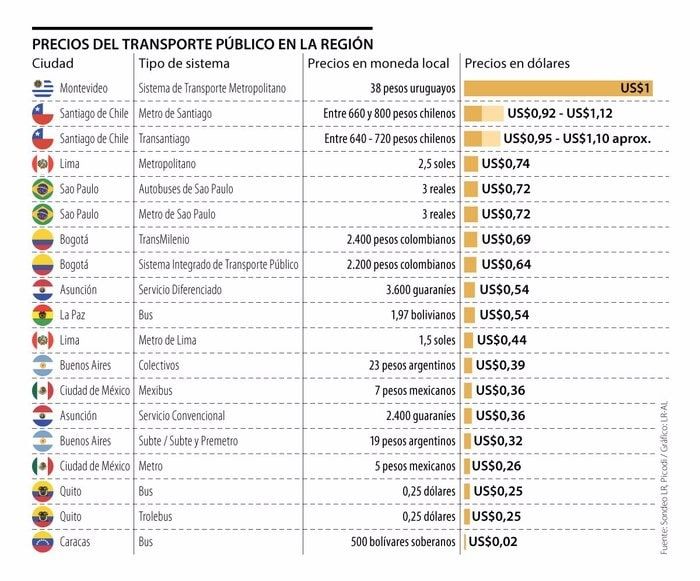Find out how much public transport costs in Latin American countries
In the context of the crisis that broke out in Chile as a result of the rise in subway prices, LR surveyed the prices of public transport tickets in the main cities of Latin America.

Montevideo, with a ticket of US$1; and Santiago de Chile, with between US$0.92 and US$1.12, lead the list of countries with the highest public transport fares in the region. The crisis in Chile does not cease. After President Sebastián Piñera's government announced an increase in subway fares of 30 Chilean pesos (US$0.04), street protests in Chile have not stopped. Interior Minister Andrés Chadwick said that 152 people were arrested on Sunday and there were more than 40 acts of looting, not to mention that the protests had left 10 dead until Sunday.
In the context of the crisis that broke out in Chile as a result of the rise in subway prices, La Republica surveyed the prices of public transport tickets in the main cities of Latin America and passed them on to dollars with Oanda, the online currency converter, to find out how expensive the price of transport is in the countries of the region.
In the survey, Santiago de Chile ranked second on the list of countries where public transport fares are most expensive. It must be understood that the prices of transport in Santiago de Chile vary according to timetables, hence the criticism made by Chileans to the Minister of Economy, Juan Andrés Fontaine, who warned that "the one who gets up early will be helped", referring to tickets for a lower value in the morning hours. Santiago's Metro prices range between US$0.92 and US$1.12, while Transantiago's are between US$0.95 and US$1.10. With this increase, the ticket went from costing Chileans US$1.12 to US$1.17, on average.
Although the rise in prices triggered the crisis in Chile, Jorge Saavedra, an academic in the Sociology Department of the University of Cambridge, explained that the origin lies "in a feeling of abuse that has been growing for decades in the population with respect to an economic-political system that is expressed in sustained increases that are not conditioned by increases in salaries. Something that, apparently, had been gestating for some years.
Montevideo's Metropolitan Transport System led the list of the most expensive in the region. In that country, the price of ticket costs, on average, US$1. Lima and Sao Paulo ranked third and fourth. The Metropolitano de Lima reaches 2.5 soles, or US$0.74, while the Buses de Sao Paulo and the Metro de Sao Paulo cost US$0.72.
Bogotá ranked fourth with prices for the TransMillennium and the Integrated Public Transport System (Sitp) at US$0.69 and US$0.64. Mexico City (US$0.26), Quito (US$0.25), and Caracas (US$0.02) ranked among the countries with the cheapest fares in Latin America.
Jorge Sahd, director of the Center for International Studies at the Catholic University of Chile, agreed with Saavedra, adding that "the cost of living has risen at a faster rate than wages, which have stagnated in recent years. This has generated a problem of income versus cost of living, with an ever-increasing level of indebtedness.
Chile is the second country with the most expensive gasoline in Latin America.
The discontent of Chileans is not only because of the price of subway tickets, it goes much further. Based on Picodi's figures, we compare gasoline with the average wages of the countries in the region and Chile also scores, along with Uruguay. The average wage for Chileans is around US$795, while the price per liter of gasoline reaches US$1.21. That being the case, this salary is only enough for 657 liters of gasoline for the average Chilean. Bolivia, Ecuador, and Venezuela have the lowest gasoline prices in the region.





